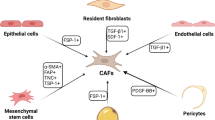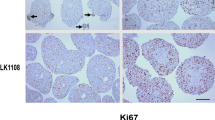Abstract
A genetically related pair of human head and neck cancer (HNSCC) cell lines derived from the same patient at different stages of disease was used to investigate the role of extracellular matrix, integrin, and CXCL12–CXCR4 receptor interactions and their signal pathways in MMP-2 and MMP-9 activation and cell invasion. We found that collagen I enhanced MMP-2 and MMP-9 secretion in both primary and metastatic HNSCC cells. Collagen I acted through α2β1 integrin to activate tyrosine kinases, protein kinase C, ERK1/2, and p38, which in turn activated MMP-2 and MMP-9 production. The signaling function was also involved in the enhancement of cell invasion. Experiments using cocultures between live and fixed cells demonstrated that direct contact between tumor and fibroblast cells was required to activate MMP-2 and MMP-9 secretion in both tumor cells and fibroblasts. The augmentation appears specific for MMP-2. Fibroblasts seem to be responsible for the increased MMP-2 in the coculture. In addition, fibroblast or tumor cell-conditioned media upregulated the secretion of MMP-2 and MMP-9 in HNSCC cells. These findings indicate that autocrine and paracrine factors are involved in the augmented secretion of MMPs in coculture. We also found that CXCL12-enhanced HNSCC cell invasion through paracrine-activated CXCR4, which triggered MMP-dependent cell invasion. Together, our results suggest that cell–matrix and cell–cell interactions including autocrine and paracrine factors play important roles in the invasive behavior of HNSCC via upregulation of MMP-2 and MMP-9.











Similar content being viewed by others
References
DeClerck YA. Interactions between tumour cells and stromal cells and proteolytic modification of the extracellular matrix by metalloproteinases in cancer. Eur J Cancer. 2000;36:1258–68.
Rosenthal EL, Matrisian LM. Matrix metalloproteases in head and neck cancer. Head Neck. 2006;28:639–48.
Morgan MR, Thomas GJ, Russell A, Hart IR, Marshall JF. The integrin cytoplasmic-tail motif EKQKVDLSTDC is sufficient to promote tumor cell invasion mediated by matrix metalloproteinase (MMP)-2 or MMP-9. J Biol Chem. 2004;279:26533–9.
Che ZM, et al. Collagen-based co-culture for invasive study on cancer cells-fibroblasts interaction. Biochem Biophys Res Commun. 2006;346:268–75.
Kulasekara KK, et al. Cancer progression is associated with increased expression of basement membrane proteins in three-dimensional in vitro models of human oral cancer. Arch Oral Biol. 2009;54:924–31.
Vo HP, Lee MK, Crowe DL. alpha2beta1 integrin signaling via the mitogen activated protein kinase pathway modulates retinoic acid-dependent tumor cell invasion and transcriptional downregulation of matrix metalloproteinase 9 activity. Int J Oncol. 1998;13:1127–34.
Reddy KB, Krueger JS, Kondapaka SB, Diglio CA. Mitogen-activated protein kinase (MAPK) regulates the expression of progelatinase B (MMP-9) in breast epithelial cells. Int J Cancer. 1999;82:268–73.
Yeudall WA, Crawford RY, Ensley JF, Robbins KC. MTS1/CDK4I is altered in cell lines derived from primary and metastatic oral squamous cell carcinoma. Carcinogenesis. 1994;15:2683–6.
Cardinali M, Pietraszkiewicz H, Ensley JF, Robbins KC. Tyrosine phosphorylation as a marker for aberrantly regulated growth-promoting pathways in cell lines derived from head and neck malignancies. Int J Cancer. 1995;61:98–103.
Thomas GJ, Lewis MP, Hart IR, Marshall JF, Speight PM. AlphaVbeta6 integrin promotes invasion of squamous carcinoma cells through up-regulation of matrix metalloproteinase-9. Int J Cancer. 2001;92:641–50.
Ondrey FG, Juhn SK, Adams GL. Inhibition of head and neck tumor cell growth with arachidonic acid metabolism inhibition. Laryngoscope. 1996;106:129–34.
Albini A, et al. A rapid in vitro assay for quantitating the invasive potential of tumor cells. Cancer Res. 1987;47:3239–45.
Lee HJ, et al. Differential induction of heme oxygenase-1 against nicotine-induced cytotoxicity via the PI3 K, MAPK, and NF-kappa B pathways in immortalized and malignant human oral keratinocytes. J Oral Pathol Med. 2008;37:278–86.
Lee SK, et al. p38 and ERK MAP kinase mediates iron chelator-induced apoptosis and -suppressed differentiation of immortalized and malignant human oral keratinocytes. Life Sci. 2006;79:1419–27.
Gopalakrishna R, Chen ZH, Gundimeda U. Tobacco smoke tumor promoters, catechol and hydroquinone, induce oxidative regulation of protein kinase C and influence invasion and metastasis of lung carcinoma cells. Proc Natl Acad Sci USA. 1994;91:12233–7.
Ravanti L, Heino J, Lopez-Otin C, Kahari VM. Induction of collagenase-3 (MMP-13) expression in human skin fibroblasts by three-dimensional collagen is mediated by p38 mitogen-activated protein kinase. J Biol Chem. 1999;274:2446–55.
Brand S, et al. CXCR4 and CXCL12 are inversely expressed in colorectal cancer cells and modulate cancer cell migration, invasion and MMP-9 activation. Exp Cell Res. 2005;310:117–30.
Redondo-Munoz J, et al. MMP-9 in B-cell chronic lymphocytic leukemia is up-regulated by alpha4beta1 integrin or CXCR4 engagement via distinct signaling pathways, localizes to podosomes, and is involved in cell invasion and migration. Blood. 2006;108:3143–51.
Aznavoorian S, et al. Membrane type I-matrix metalloproteinase-mediated degradation of type I collagen by oral squamous cell carcinoma cells. Cancer Res. 2001;61:6264–75.
Dong Z, et al. Differential regulation of matrix metalloproteinase-9, tissue inhibitor of metalloproteinase-1 (TIMP-1) and TIMP-2 expression in co-cultures of prostate cancer and stromal cells. Int J Cancer. 2001;93:507–15.
Ellerbroek SM, Wu YI, Overall CM, Stack MS. Functional interplay between type I collagen and cell surface matrix metalloproteinase activity. J Biol Chem. 2001;276:24833–42.
Azzam HS, Thompson EW. Collagen-induced activation of the M(r) 72, 000 type IV collagenase in normal and malignant human fibroblastoid cells. Cancer Res. 1992;52:4540–4.
Roeckel D, Krieg T. Three-dimensional contact with type I collagen mediates tyrosine phosphorylation in primary human fibroblasts. Exp Cell Res. 1994;211:42–8.
Chakrabarti S, Zee JM, Patel KD. Regulation of matrix metalloproteinase-9 (MMP-9) in TNF-stimulated neutrophils: novel pathways for tertiary granule release. J Leukoc Biol. 2006;79:214–22.
Zeng ZZ, et al. Role of focal adhesion kinase and phosphatidylinositol 3′-kinase in integrin fibronectin receptor-mediated, matrix metalloproteinase-1-dependent invasion by metastatic prostate cancer cells. Cancer Res. 2006;66:8091–9.
Westermarck J, Kahari VM. Regulation of matrix metalloproteinase expression in tumor invasion. FASEB J. 1999;13:781–92.
Kawahara E, Nakada N, Hikichi T, Kobayashi J, Nakanishi I. EGF and beta1 integrin convergently regulate migration of A431 carcinoma cell through MAP kinase activation. Exp Cell Res. 2002;272:84–91.
Koontongkaew S, Amornphimoltham P, Yapong B. Tumor-stroma interactions influence cytokine expression and matrix metalloproteinase activities in paired primary and metastatic head and neck cancer cells. Cell Biol Int. 2009;33:165–73.
Constantin G, et al. Chemokines trigger immediate beta2 integrin affinity and mobility changes: differential regulation and roles in lymphocyte arrest under flow. Immunity. 2000;13:759–69.
Daly AJ, McIlreavey L, Irwin CR. Regulation of HGF and SDF-1 expression by oral fibroblasts–implications for invasion of oral cancer. Oral Oncol. 2008;44:646–51.
Uchida D, et al. Possible role of stromal-cell-derived factor-1/CXCR4 signaling on lymph node metastasis of oral squamous cell carcinoma. Exp Cell Res. 2003;290:289–302.
Samara GJ, et al. CXCR4-mediated adhesion and MMP-9 secretion in head and neck squamous cell carcinoma. Cancer Lett. 2004;214:231–41.
Airoldi I, et al. CXCL12 does not attract CXCR4 + human metastatic neuroblastoma cells: clinical implications. Clin Cancer Res. 2006;12:77–82.
Yeudall WA, Miyazaki H. Chemokines and squamous cancer of the head and neck: targets for therapeutic intervention? Expert Rev Anticancer Ther. 2007;7:351–60.
Acknowledgments
This work was supported by research grants from Thailand Research Foundation (TRF) and Thammasat University. We thank Dr. Silvio Gutkind (NIDCR, Bethesda, MD, USA) for the HNSCC cell lines used in our studies. We also thank Dr. Matthew J Cheesman for editing the manuscript.
Author information
Authors and Affiliations
Corresponding author
Rights and permissions
About this article
Cite this article
Koontongkaew, S., Amornphimoltham, P., Monthanpisut, P. et al. Fibroblasts and extracellular matrix differently modulate MMP activation by primary and metastatic head and neck cancer cells. Med Oncol 29, 690–703 (2012). https://doi.org/10.1007/s12032-011-9871-6
Received:
Accepted:
Published:
Issue Date:
DOI: https://doi.org/10.1007/s12032-011-9871-6




